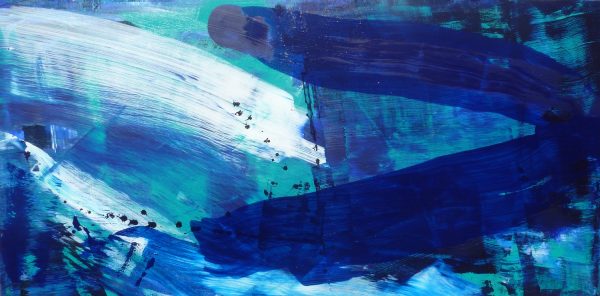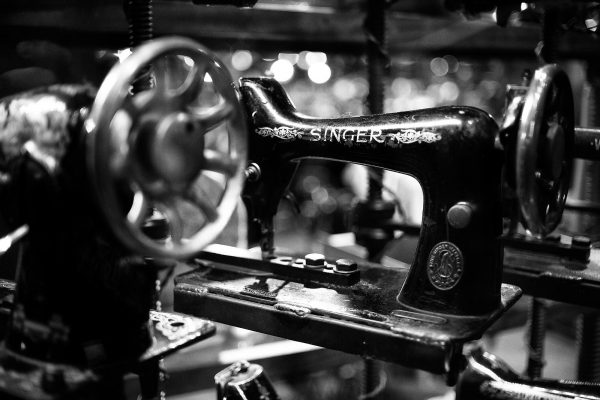1. A book describes works that the author has conceived but not brought into being.
2. The world is drawn from memory. There are missing countries, altered borders.
3. Proust’s head is drawn on a page of In Search of Lost Time. The words tracing out the contour of his face form a grammatically correct sentence.
4. Man-sized aluminium mannequins are dropped at different heights from a crane. Metamorphosed by folds, they adopt the pose to which they are constrained by their new morphology.
5. An exhibit displays pieces unalike in spirit, style, and technique, but with the same origin: their author saw them while dreaming.
6. Entomological boxes contain invitation cards to exhibitions that didn’t take place. The reasons for their cancellation are written below the cards. The boxes are hung on the walls like a collection of insects.
7. A woman’s voice describes the shapes she sees in the static snow on the television screen after the end of broadcasts. Geometric forms, windmills, ghosts. The video is shown on a monitor posed on a low table at the foot of a divan couch. The visitor lies down and compares what he sees to what he hears.
8. Museum of Nobodies. Instead of the usual celebrities, a wax museum displays unknown characters. Chosen at random from the telephone book, the models are representative of neither an epoch, nor a region, nor a profession. At its inauguration, the museum shows thirty statues. Two new models are added to the museum’s collection each year: as the years go by, an evolving, sculptural, and hyperrealist memory of society emerges.
9. Every year in January, a painting is made from memory of the same photograph, which represents a square in Bangkok during a time of affluence. Neither the model image, nor the preceding paintings are looked at. After ten years the paintings are revealed and exhibited alongside one another.
10. A film scene is shown backwards to actors so they can learn to act it in reverse. Once they succeed, they are filmed anew. The new scene, in turn projected backwards, becomes strange: reversing the inversion doesn’t get you back to where you started.
11. The friend of an artist selects descriptions of artworks from press reviews of exhibitions. The accompanying photograph is cut out and the text sent to the artist to draw the work based on its description. The final work is a triptych composed of the drawing, the description of the work, and the photograph accompanying the article. There are four authors, direct or indirect, voluntary or involuntary: the artist who created the referenced work, the writer of the article, the friend who chose it, and the artist who drew it.
12. A scene reflected in the retina of an eye. Photograph.
13. A sculpture represents a man whose extremities, instead of jutting out, extend into the interior of his body. The head, hands, feet, and genitals are folded in. The man sits on the ground, legs spread and arms folded. Marble.
14. The floor of a cage is littered with pages from the Old Testament. For a month, a record is kept of the words upon which a hummingbird comes to rest. A text is written using only these words.
15. A leather jacket made from a mad cow.
16. A hundred pictorial or sculptural representations of a biblical character, from different times and countries, are photographed using the same framing. A print is made by superimposing the negatives. Appearing in a halo are the average faces of Adam, Eve, Mary, Jesus, and God.
17. A litre of molten lead is poured out in zero gravity in a vacuum. Brought back to earth, it is exhibited in the form into which it has hardened.
18. The Mimic. In a yellow hall lit by yellow light, the voice of an artist is heard telling his life story in the form of an anamnesis, from his birth right up to the day of the exhibition. The voice is not his, but that of a professional mimic. Yet nothing gives this away.
19. A butterfly is released into a room, hidden from sight. Every night, its flight, detected by laser beams, is transmitted to a mobile machine equipped with an hourglass. By morning, the imprint of the nocturnal flight is drawn in sand on the floor.
20. In the United States a voyage is undertaken to photograph towns with names that are homonyms of towns in other countries. The itinerary, which connects them by passing through each town only once, goes around the country in thirteen thousand kilometres. The trajectory commences in New York, follows the coast to the south, heads west up to the Pacific, climbs back up north, and follows the Canadian border to the north-east before returning to the starting point. The route is traversed by car. The towns crossed are, in alphabetic order:
AMSTERDAM, BAGDAD, BELFAST, BELGRADE, BELLEVILLE, BERLIN, BETHLEHEM, BETHUNE, BRISTOL, CALAIS, CAMBRIDGE, CANTON, CARLSBAD, CARTHAGE, CLERMONT, CUBA, DELHI, DUBLIN, FLORENCE, FRANKFORT, GLASGOW, HEIDELBERG, JERICHO, JOHANNESBURG, LIMA, LIVERPOOL, MACON, MADRAS, MADRID, MANCHESTER, MELBOURNE, MEXICO, MILAN, MILO, MONTEVIDEO, NAPLES, ODESSA, OXFORD, PANAMA, PARIS, PEKING, POTSDAM, ROME, ROTTERDAM, SAINT-CLOUD, SEVILLE, STOCKHOLM, STUTTGART, SYRACUSE, TORONTO, TOULON, VERSAILLES.
In these towns, photographs are taken of places that are ‘common’ in the double sense of being banal and being gathering spots for the community. Each photograph is accompanied by a title: Cuba’s Town Hall; A Bar in Berlin; Supermarket in Rome; Hair Salon in Paris; A Street in Versailles. Descriptions that are misleading, without being false.
21. A pillow is filled with feathers lost by birds at the moment of taking flight. On the white pillowcase is embroidered: ‘Flythms’.
22. Paintings combine contradictory techniques, formats, styles, or modes of presentation.
A grey monochrome in a gilded baroque frame. A geometric painting with matter-painting impastos. A large-scale miniature. A Chinese scroll depicting Paris. A blurry hyperrealist picture. A pop art portrait of the cardinal de Retz.
23. During a film shoot, the actors don’t open their mouths, but inwardly speak their lines. They are then dubbed using their own voices. Though synchronic, the sound and image remain dissociated.
24. A house designed by a three-year-old is built.
25. A lunette before a window, inside an exhibition space situated on an overhang, allows one to see works installed in a village a few kilometres away in the background. Their positions (in gardens, on rooftops, behind walls) make the works invisible from the village itself.
26. A building is transformed into a cemetery. The rooms become vaults.
27. Cello pieces written by amateurs, with the aid of an arranger and a cellist. The former musically translates suggestions by the amateur, which the latter plays for him to judge and correct. A professional soloist plays the finished pieces. A record is released.
28. The number of works in a museum is added to without the knowledge of its employees. False modern and contemporary pieces, or ones that are authentic and donated by living artists who are in on the ruse, are deposited in the storerooms. Three people make appointments with a curator to consult artworks kept there. While two of them distract the curator, the third plants a small parasitic piece in the collection.
29. A picture is painted. A detail, copied onto another canvas, acts as a point of departure for a second picture. A detail, copied from the second picture, different to the preceding one, is copied onto a third canvas, on which another picture takes shape around it. And so on. The series is a chain, of which the pictures are the links, and the details the points where they meet.
30. A house is built without the use of measurement. Each measure is intuitively estimated. The materials are contemporary and the banal style is that of mass-produced houses. At first blush, the house seems normal. Looking closer, one sees numerous errors. The partitions are poorly joined. The steps are poorly assembled. The flagstones are not parallel to the walls. These, along with the windows and the doors, are not set square. The roof is not watertight.
31. Veterans of Joy. Aged hedonists, men and women more than sixty years old, are photographed in their homes. Old rock stars, clubbers, demimondaines, swingers, porn stars.
32. The instruction manual of a piece of translation software is subjected to translation, twice, by that same software, from a foreign language and back again. The work consists of a copy of the original guide alongside the pretty different, doubly translated text.
33. The noises heard in a landscape are written on the walls and floor of a room. The size of the lettering is proportional to the intensity and distance of their sounds. Their position on the wall corresponds to where they appear in the landscape.
‘Crickets
Slow shrill birdsong
The buzz of a fly
Children playing in the distance
Bird whistling, several shrill notes
Bird shrieking, tapering off
Children speaking in the distance
Crickets
Shrill bird whistle
An adult addressing the children in the distance
Slide of a ballpoint pen over a sheet of paper
The moo of a cow
Shrill bird
Buzz of a fly, it comes to rest, its legs knocking against the plastic table
Flight of a bumblebee
Scratching of my nails on my shoulders
I sniff
I breathe
Shrill bird
Cuckoo
I swallow
I move the notebook, scraping against the plastic table
Airplane far off
Wasps around the nest they’re building
Fly on my left arm
I chase it off: the bones in my shoulders creak
Telephone.’
34. The hanging of a museum’s permanent collection is changed for the duration of an exhibit. The choice of works remains the same, but the order of their appearance in the flow of halls changes. They are ordered by decreasing size.
35. Fake drawings by artists from the early twentieth century are folded up and inserted into books in provincial libraries. The books are chosen for the coincidence of their dates of publication and the supposed dates of the drawings. At an undetermined date, a reader discovers the work. Not imagining that it might be a fake, since the usual motive for forgery – the financial enrichment of the forger – is not operative here, experts authenticate the drawing. The artist’s body of works is augmented. Wrongly so.
36. Music for a single instrument is written by transcribing texts into musical scores. For each letter there is a corresponding note. The spaces between words mark rests. The choice of notes corresponding to letters determines the tune.
37. A photograph of a man’s face is cut down the middle from top to bottom. One half is kept protected from the light. The other is taped to the man’s place of residence, exposed to the sun and elements. One year later, the photograph is reconstituted by reassembling the two pieces.
38. An artist is filmed under hypnosis. The videotape shows the beginning of the session, the wait, and then his passage into a hypnotic state. The hypnotist’s voice accompanies the images. His awakening is not recorded. Watching the video plunges the artist back into a state of hypnosis that only the hypnotist can bring him out of. The hypnotist not being present, the artist cannot take the risk of watching the tape. Having chosen to show it, he is the only one who cannot watch it.
This is an extract, originally published in The White Review No. 7, from Works (Dalkey Archive Press).
ABOUT THE CONTRIBUTOR
Jan Steyn is a translator and critic of literatures in Afrikaans, Dutch, English and French. He currently teaches at the Université de Paris 8 in France.



